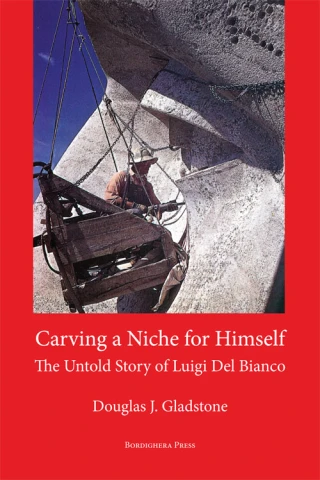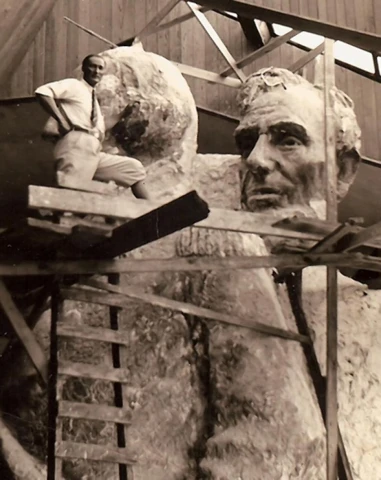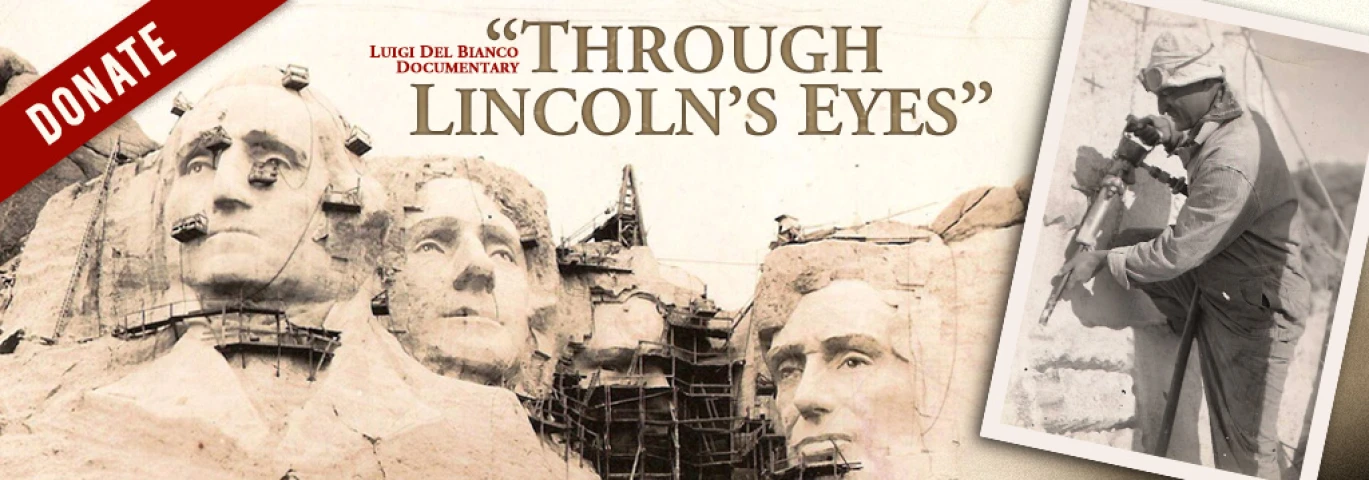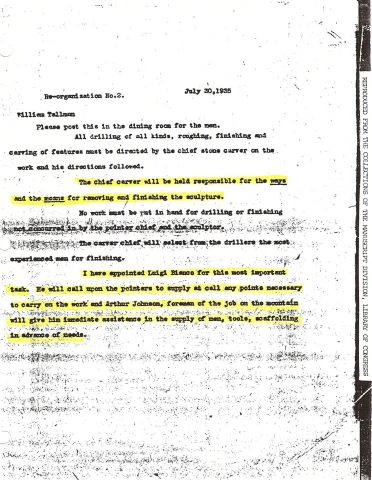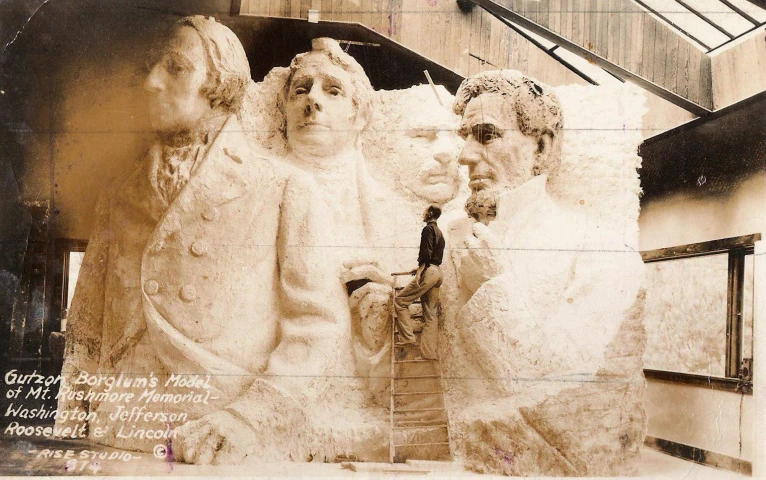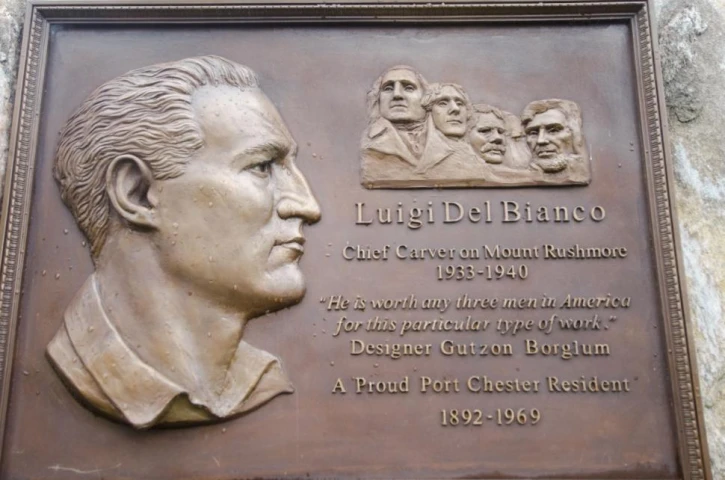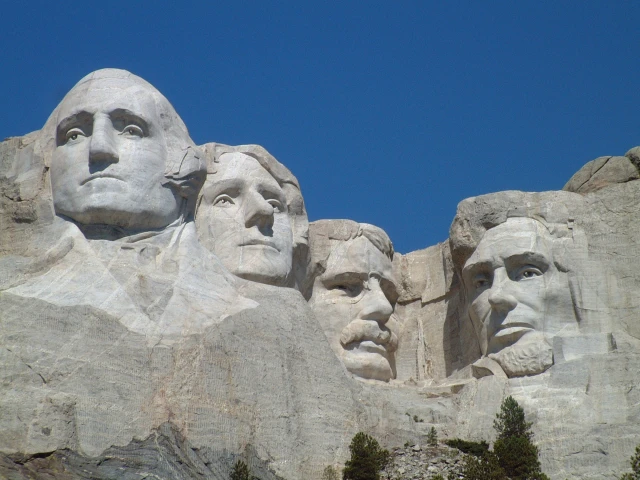There are many ways to analyze the contribution of the Italian Americans to the society, the economy, the culture, the greatness of the United States. One of these ways is celebrating those who have given their talent and their hard work to build monuments known and loved by every American, and not only by the Americans.
There's an Italian who contributed with a very important role to build a unique monument, the most famous of the United States. Only a few Italian Americans know of him, and almost nobody knows his story in Italy: we're talking about Luigi Del Bianco, chief carver of the Mount Rushmore National Memorial. Douglas Gladstone has written a book about this, "Carving a Niche for Himself: The Untold Story of Luigi Del Bianco and Mount Rushmore", and he accepted to tell us something more about this very talented and brave fellow Italian.
Douglas, who was Luigi Del Bianco?
Born in 1892, Del Bianco was from the municipality of Meduno, in the Province of Pordenone, which produced a lot of talented taiapiera (stonemasons). The area is known as Friuli Venezia Giulia. These artisans were called the "Spizzapiera di Midun."
What was Del Bianco's job in the construction of Mount Rushmore?
Luigi was responsible for giving each of the presidential faces their "refinement of expression." He did more than blast away at the granite to sculpt the four figures - he gave the monument its soul, as anyone who has looked into the pupils of Lincoln's eyes can attest.
Please tell us something about your admirable commitment against the United States Department of the Interior's National Park Service (NPS), which has consistently refused to recognize Luigi Del Bianco as the chief carver of the Mount Rushmore National Memorial.
Well, first and foremost, thank you for your kind and gracious compliment. I suppose I am a person who believes that you cannot expect justice for yourself unless others have justice as well. That's one reason I got involved in this. There's also the incontrovertible evidence that exists. No less than Rushmore sculptor and designer Gutzon Borglum himself refers to Del Bianco as the chief carver in a July 30, 1935 letter.
Yet the people at the Parks Service have been totally dismissive. Luigi's late son, Caesar, found this letter in the Manuscripts Division of the Library of Congress, yet one official after another has chosen to downplay its historical significance and overlook it. And I think that's a gross miscarriage of justice. If Gutzon Borglum himself calls Del Bianco the chief carver, why isn't that good enough for the U.S. government?
But the other reason is that Luigi is being lumped together with the other workers. That might be egalitarian, but it's narrow minded thinking. You will never convince me that the man who was the hoist engineer -- the person who ran the elevator lift -- should receive the same credit as Luigi. You or I could probably learn to operate an elevator lift. I doubt the opposite would be true, that is, the hoist engineer couldn't learn what it takes to be a sculptor. The skill set and craftsmanship that Del Bianco employed while working on those faces can't just be learned in a few minutes.
I mean, it's ludicrous. Even Borglum's stenographer gets the same kind of credit on the "Worker's Wall" as Del Bianco, and I know she didn't risk her life swinging 600 feet in the air on a bosun's chair.
My November 3 dialogue with the official agency historian, Bob Sutton, proved to be overwhelmingly constructive and positive. I am pleased the agency is at long last leaning towards increased recognition for Del Bianco.
Why is Mount Rushmore so important in the history of the United States?
Located in Keystone, South Dakota, Mount Rushmore is one of the world's most renowned sculptures. The memorial, which turns 75 next year, has moved beyond the single focus of the faces of the four US presidents to embrace the vast diversity of cultural traditions and stories that make up Americans' national heritage. That's why I feel the US government is dropping the ball so badly by not telling the Del Bianco narrative; if the story of an immigrant to these lands, who worked on what is arguably the most iconic landmark in this country, isn't the realization of the American dream for a person to these shores, I don't know what is.
You are also working on the project of a documentary about the Del Bianco family, called "Through Lincoln's Eyes"...
The documentary is being helmed by a Peabody Award-winning producer and writer named Taryn Grimes Herbert, and I was filmed this past August speaking with a gentleman named Cam Sholly, who is the Midwestern Regional Administrator for the Parks Service. It was a very frank and candid discussion, and I hope I swayed him to my point of view, namely, that Del Bianco deserves posthumous recognition for his work at the memorial. I think it's why this story should resonate with people. Who among us haven't felt at some time or another cheated out of the credit we feel we're deserving of? So just from a perspective of equity and fairness, I'm hoping the federal government remedies this slight.
What would you like to tell our fellow Italians who live either in the US and in Italy about Luigi Del Bianco?
This is a great immigrant success story that is not part of the narrative currently being told at the memorial. When tourists visit, the park rangers aren't informing them of the work of this skilled artisan. And that's a shame. The contributions of immigrants built America. For instance, many of the men responsible for the stonework at the National Cathedral in Washington, D.C. were of Italian descent. But does anyone know their names? Ermelindo Eduardo Ardolino is known for his work at the Cathedral of Saint John the Divine, in Manhattan, but who knows of Luigi Del Bianco's work at Mount Rushmore?
Another reason why I feel so strongly about this is that there's always been a pejorative image of Italian Americans. Reality shows such as "Mob Wives" and "Jersey Shore" help perpetuate this image. Well, Luigi can be seen as a new, refreshing and positive symbol of what it means to be an Italian American, as a role model that someone can choose to emulate.
Does Italy, in any way, recognize or remember Luigi Del Bianco?
I know the Italian Consul General in New York, Natalia Quintavalle, knows about Del Bianco, but I don't know if the Italian government intends to formally do anything.
Michele Bernardo, the head of the Museo Provinciale Della Bita Contadina "Diogene Penzi" - Sezione Lavoro ed Emigrazione ( Provincial Museum of Rural Life - Section of Work and Emigration) in Cavasso Nuovo, a town near Meduno, has established an exhibition area to all the Friuli people which prominently features Del Bianco.
And in Meduno itself, a local hair stylist named Andreino Ferroli has turned his barber shop into something of a shrine to Luigi. His late aunt was apparently related to the Del Bianco family.
Of course, I'd like to see more done. This reflects well on the Italian people, that one of their own is associated with such an iconic American landmark and world renowned sculpture.
And if you permit me, I'd like to express my gratitude to someone who I never even met: a woman named Maria Cristina Piccini, of the Pordenone Tourism Office. I am especially indebted to her because my mastery of Italian is not that good ... "il mio Italiano è ancora molto brutto".
Where can our readers find a copy of your book?
New Yorkers can order directly from my publisher, Bordighera Press, by telephoning 212-642-2001 or accessing the following link: http://www.bordigherapress.org/ViaFolios4.html. Anyone else worldwide can contact Small Press Distribution, of Berkeley, California, at: http://www.spdbooks.org/Producte/9781599540672/carving-a-niche-for-himself-the-untold-story-of-luigi-del-bianco-and-mount-rushmore.aspx
Ci sono molti modi per analizzare il contributo degli italoamericani alla società, all'economia, alla cultura e in definitiva alla grandezza degli Stati Uniti. Uno di questi modi celebra coloro che hanno donato il loro talento e il loro duro lavoro per costruire alcuni monumenti conosciuti e amati da tutti gli americani, e non solo dagli americani.
C'è un italiano che ha avuto un ruolo fondamentale nella costruzione di un monumento unico al mondo, il più famoso degli Stati Uniti. Solo pochi italoamericani ne conoscono la storia, e quasi nessuno lo conosce in Italia: stiamo parlando di Luigi Del Bianco, che fu a capo di coloro che lavorarono al Mount Rushmore National Memorial. Douglas Gladstone ha scritto un libro su questo argomento, "Carving a Niche for Himself: The Untold Story of Luigi Del Bianco and Mount Rushmore", ed ha accettato di dirci qualcosa di più su questo italiano talentuoso e coraggioso.
Douglas, chi era Luigi Del Bianco?
Nato nel 1892, Del Bianco proveniva dal comune di Meduno, in provincia di Pordenone: il Friuli Venezia Giulia è una zona dalla quale arrivarono molti italiani con grande talento nella lavorazione della pietra. Questi artigiani erano chiamati gli "Spizzapiera di Midun."
Quale fu il ruolo di Del Bianco nella costruzione del Monte Rushmore?
Luigi era incaricato di conferire quella che fu chiamata la "raffinatezza dell'espressione" a ciascuno dei volti presidenziali. Luigi ha fatto molto più che semplicemente lavorare il granito per scolpire le quattro figure: ha dato al monumento la sua anima, come può constatare chiunque abbia guardato le pupille di Lincoln.
Dicci qualcosa a proposito del tuo ammirevole impegno contro lo United States Department of the Interior's National Park Service, che ha sempre rifiutato di riconoscere Luigi Del Bianco come il capo scultore del Mount Rushmore National Memorial
Beh, prima di tutto, grazie per il tuo gentile complimento. Io credo che non ci si possa aspettare giustizia per sé stessi se lo stesso non vale anche per gli altri. E' per questo che mi sono impegnato in questa battaglia, a favore della quale esiste anche una prova incontrovertibile. Fu lo stesso designer del Monte Rushmore, Gutzon Borglum, a riferirsi a Del Bianco come il capo scultore in una lettera del 30 luglio del 1935.
Eppure le persone al Servizio Parchi sono sembrate rimanere finora totalmente indifferenti. Il figlio di Luigi, Cesare, trovò questa lettera nella Divisione Manoscritti della Biblioteca del Congresso a Washington, ma uno dopo l'altro ogni ufficiale ha scelto di minimizzare il suo significato storico e dimenticarla. E penso che sia una profonda ingiustizia. Se Gutzon Borglum definisce Del Bianco il capo scultore, perché non è sufficiente per il governo degli Stati Uniti?
Un'altra ingiustizia è che Luigi viene accomunato a tutti gli altri lavoratori. Questa potrebbe sembrare una scelta equa, ma in realtà dimostra una visione limitata. Nessuno potrà mai convincermi che l'ingegnere di sollevamento - la persona che manovrava l'ascensore - dovrebbe ricevere lo stesso credito di Luigi. Tu e io potremmo forse imparare a gestire un ascensore. Dubito che il contrario sia vero, cioè, che quell'ingegnere potesse mai riuscire a scolpire con l'abilità e la maestria che Del Bianco dimostrò mentre lavorava su quelle facce: queste doti non possono essere apprese in pochi minuti, e non sono affatto comuni.
E' ridicolo. Sul "Worker's Wall" (l'elenco di chi ha contribuito a Mount Rushmore, scolpito su un muro), persino la stenografa di Borglum ottiene lo stesso tipo di credito di Del Bianco, e lei non ha certo rischiato la sua vita oscillando in una scomoda e pericolosa imbragatura a 180 metri da terra.
Tuttavia, ho avuto lo scorso 3 novembre un dialogo con lo storico ufficiale dell'agenzia, Bob Sutton, che si è rivelato positivo e costruttivo. Sono lieto che l'agenzia stia finalmente propendendo verso un riconoscimento per Del Bianco.
Perché il Mount Rushmore è così importante nella storia degli Stati Uniti?
Il Monte Rushmore, che è a Keystone, nel Sud Dakota, è una delle sculture più famose del mondo. Il memoriale, che compirà 75 il prossimo anno, ha un significato che va al di là del fatto di rappresentare i volti di quattro Presidenti degli Stati Uniti: tale significato arriva ormai a rappresentare la grande diversità delle tradizioni culturali e delle storie che compongono il patrimonio nazionale degli americani. Ecco perché sento che il governo degli Stati Uniti sbaglia così tanto nel non voler riconoscere e raccontare la storia di Del Bianco: se la storia di un immigrato arrivato in questa terra, che ha lavorato su quello che è probabilmente il punto di riferimento più iconico di questo Paese, non è la realizzazione del sogno americano ... io non so cosa altro possa esserlo.
Stai anche lavorando al progetto di un documentario sulla famiglia Del Bianco, chiamato "Through Lincoln's Eyes" (attraverso gli occhi di Lincoln) ...
Il documentario è portato avanti da uno scrittore, nonché produttore già vincitore del Peabody Award, Taryn Grimes Herbert, e la mia parte è stata girata lo scorso agosto: nel filmato ho parlato con Cam Sholly, che è l'amministratore del Servizio Parchi per la regione del Midwest. E' stata una discussione molto franca e sincera, e spero di convincerlo del mio punto di vista, cioè che Del Bianco merita un riconoscimento postumo per il suo lavoro presso il monumento. Penso che sia il motivo per cui questa storia dovrebbe essere raccontata e raggiungere più gente possibile. Chi di noi, in qualche momento della propria vita, non si è sentito defraudato del credito e del merito che ritiene di meritare? Quindi, in una prospettiva di equità e di giustizia, spero che il governo federale rimedi a questo errore.
C'è qualcos'altro a proposito di Luigi Del Bianco che vorresti dire ai nostri connazionali che vivono sia negli Stati Uniti che in Italia?
Questa è una storia di grande successo di un immigrato, che però al momento non fa parte della narrazione in corso relativa a questo prestigioso monumento. Quando i turisti lo visitano, i ranger del parco non li informano del ruolo così importante avuto da questo artigiano italiano così specializzato. E questo è un peccato. E' grazie al contributo degli immigrati che si è costruita l'America. Ad esempio, molti degli uomini responsabili della pietra con cui si è costruita la National Cathedral di Washington, DC erano di origine italiana. Ma qualcuno sa i loro nomi? Ermelindo Eduardo Ardolino è conosciuto da qualcuno per il suo lavoro presso la Saint John the Divine Cathedral (la Cattedrale di San Giovanni il Divino), a Manhattan: ma chi conosce l'opera di Luigi Del Bianco al Monte Rushmore?
Un'altra ragione per cui sento così fortemente questo tema è che c'è sempre stata un'immagine peggiorativa degli italoamericani. Reality show come "Mob Wives" e "Jersey Shore" hanno continuato ad alimentare questa immagine negativa. Beh, Luigi può essere visto come un nuovo, fresco e positivo simbolo di ciò che significa essere un italoamericano, come modello vincente che qualcuno possa scegliere di emulare.
In Italia c'è qualcuno che, in qualche modo, riconosce o ricorda Luigi Del Bianco?
So che il Console Generale Italiano a New York, Natalia Quintavalle, sa di Del Bianco, ma non so se il governo italiano intende fare qualcosa.
Michele Bernardo, il capo del Museo Provinciale della Civiltà Contadina - Sezione del Lavoro e dell'Emigrazione a Cavasso Nuovo, una cittadina nei pressi di Meduno, ha creato uno spazio espositivo dedicato ai friulani, che ha un posto di rilievo per Del Bianco.
Nella stessa Meduno, un parrucchiere locale di nome Andreino Ferroli ha trasformato il suo negozio di barbiere in qualcosa simile ad un santuario dedicato a Luigi. La sua defunta zia era apparentemente legata alla famiglia Del Bianco.
Certo, a me piacerebbe vedere che si faccia ancora di più. Sarebbe un prestigio per tutto il popolo italiano, la promozione del fatto che un italiano ha contribuito così sostanzialmente ad un luogo così famoso in tutto il mondo, un fondamentale punto di riferimento per gli Stati Uniti.
E se mi permetti, vorrei esprimere la mia gratitudine a qualcuno che non ho mai incontrato di persona: una donna di nome Maria Cristina Piccini, che lavora presso l'Ufficio del Turismo di Pordenone. Mi ha aiutato molto e sono particolarmente in debito con lei, perché la mia padronanza della lingua italiana non è buona.
Dove è possibile per i nostri lettori comprare una copia del tuo libro?
I newyorkesi possono ordinarlo direttamente dal mio editore, Bordighera Press, telefonando al 212-642-2001 o al seguente link:
http://www.bordigherapress.org/ViaFolios4.html
Chiunque altro in tutto il mondo può contattare la Small Press Distribution di Berkeley, California, a questo link:
http://www.spdbooks.org/Producte/9781599540672/carving-a-niche-for-himself-the-untold-story-of-luigi-del-bianco-and-mount-rushmore.aspx


